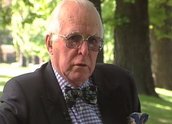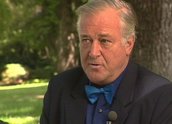

The Book Show – Jim McClelland (1991)
Synopsis
Dinny O’Hearn and Andrea Stretton begin this weekly magazine program on Australia Day at Bondi Beach, where they discuss the different meanings of this special day for different groups of Australians. Then Dinny shows an interview he completed in Melbourne with Jim McClelland, whose new book – Conversations in Cabs (1990) – is a collection of his weekly Sydney Morning Herald articles over the years.
Also in this program Dinny interviews the Cambodian-Australian survivor of the Pol Pot regime, Hout Him, and Andrea Stretton talks to John Tranter and Philip Mead about their selection of contemporary poets for the Penguin anthology of Australian poetry.
Curator’s notes
Dinny O’Hearn, who died in 1993, and Jim McClelland (1915-1999) are both from Melbourne. They do this interview sitting beneath a grove of elm trees, which Jim remembers from 60 years before when the trees were already fully grown. He is a great raconteur and talks about his life and times with wit and intelligence. And Dinny O’Hearn is just the man to relish the colour and verve of McClelland’s memories.
Jim McClelland began life as a 'fundamentalist Catholic’, to use his own words. He then became a committed Marxist during his youth. These days he says he no longer believes in a black-and-white approach to the world. His political biography is called Stirring the Possum (1988), and in it he describes his education with the Christian Brothers and becoming a Trotskyist in the 1940s. A child of the great Depression, he was a lawyer who remained clear-sighted about lawyers, a judge equally clear-sighted about the judiciary and a journalist who was always clear-sighted about the media. He became the first Chief Justice of the Land and Environment Court of NSW in 1980 and in 1984 commissioner for the Royal Commission into British Nuclear tests at Maralinga. He died on 16 January 1999 in his beloved Blue Mountains home with his wife, the journalist Gil Appleton, by his side. He lived a rich and full life as a participant and observant chronicler of one of the most interesting periods in Australia’s history.
- Overview
- Curator’s notes
- Video 2 clips
- Principal credits
- Find a copy
- Make a comment
- Add your review



